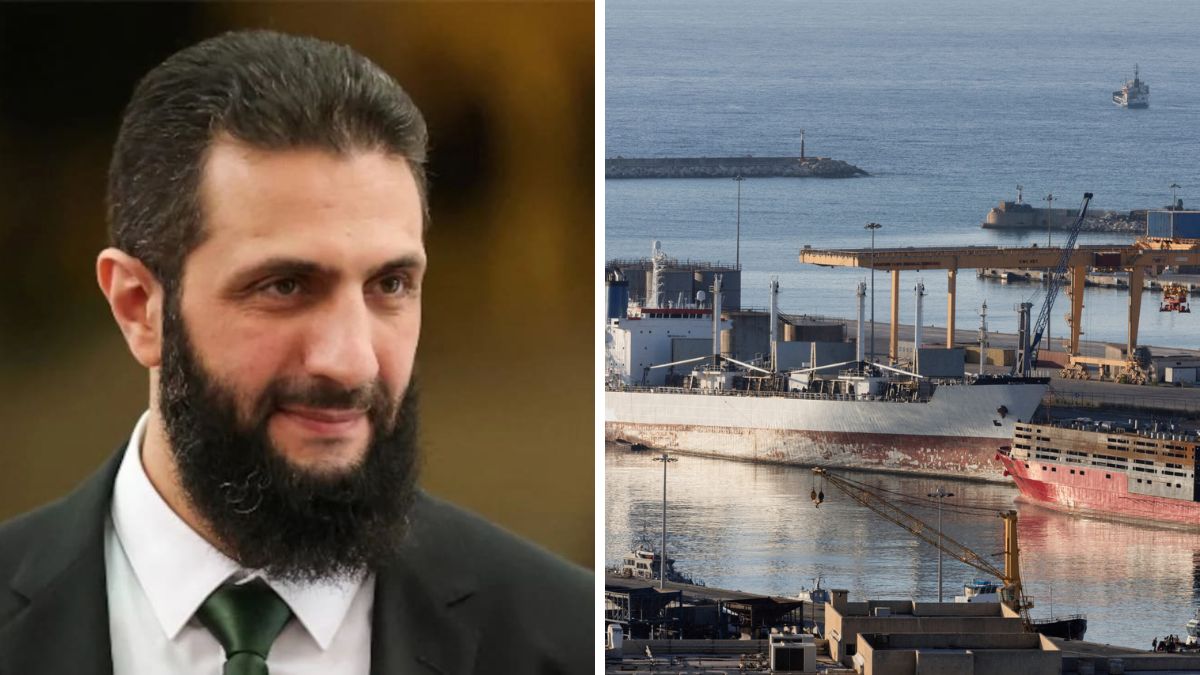How Syrian maritime assets are changing hands from Moscow to Dubai
 Syria’s interim President Ahmed al-Sharaa. (Right) Syria's Tartous Port | X
Syria’s interim President Ahmed al-Sharaa. (Right) Syria's Tartous Port | X
Reeling from the economic implications of a protracted war and sanctions, Russia might be losing its essential footholds in a new, more pragmatically oriented Syria. This does not represent Syria’s reprisal against Russia for its long-standing support for the now-deposed Bashar al-Assad. Syria’s interim President Ahmed al-Sharaa and Russian President Vladimir Putin have maintained communication, with the former alluding to building better ties on multiple occasions. However, in an increasingly fragmented geopolitical landscape, the Syrian leadership is prioritising the preservation of its precarious relative stability, sometimes to the detriment of the Russians. In line with this realistic approach comes the Tartous Port, which could be seen as another challenge to the Russian influence in the country.
Within days after President Donald Trump met with al-Sharaa in Riyadh and pledged an incremental waiver of sanctions imposed on Syria since 1979, Damascus cemented a landmark MoU with the Dubai-based maritime and logistics powerhouse DP World for the development and management of its strategically important Tartous Port and building an adjacent economic zone. The massive US$800 million deal, concluded on 15 May 2025, is monumental for several reasons.
As a multipurpose facility, the Tartous port has housed the Russian naval base since 1971 during the Cold War era, as the USSR sought to expand its presence in the Eastern Mediterranean beyond its facilities in Alexandria and Mersa Matruh, Egypt. However, as the relationship between Egypt and the Soviet Union deteriorated under Egyptian President Anwar Sadat, its access rights were incrementally rescinded, culminating in the termination of their Friendship Treaty in 1976. It finally led to the USSR transferring its assets from its two Egyptian facilities to Tartous, elevating the role of the Syrian base in its regional maritime strategy.
Even after the disintegration of the USSR, Tartous remained intact, constituting Russia’s only naval outpost outside the territories of the erstwhile Soviet states. It gained renewed prominence with Russian intervention in Syria’s civil war in 2015, serving as a crucial logistics hub for arms shipments and military support to the Assad government. Throughout the civil war, Tartous Port, together with the Hmeimim air base in Latakia and numerous other smaller bases and observation posts, ensured a strong Russian footprint across western Syria. Today, following the fall of the Assad regime and the ensuing military evacuation, these two remain Russia’s only strongholds in the country.
The Tartous port is Syria’s second-largest port and sits fortuitously along international trade routes. However, the civil war and mounting sanctions had rendered it largely dysfunctional. In 2019, the Assad government and Russia’s STG Engineering entered into a 49-year contract for its reconstruction and management, effectively granting Russia dominance over both its commercial and military operations. However, it was unilaterally cancelled in January this year by the new Syrian government on the grounds that the company failed to meet its US$500 million contractual obligation for infrastructural investment.
In that case, DP World emerges as an ideal successor. While STG has a global portfolio spanning 20 countries and a high-profile client base, its expertise is primarily focused on oil and gas infrastructure. In contrast, DP World, established in 2005 after the merger of the domestic and international authorities, has leveraged the experience of managing the Jebel Ali port and adjacent economic zone, JAFZA, to build a formidable global footprint in port and terminal operations.
Earlier in May, Syria renewed its contract with France’s CMA CGM company, originally concluded in 2009, for managing its largest Latakia port for another 30 years. Both CMA CGM and DP World are among the world’s top ten port and terminal operators. The former operates across 160 countries, with primary expertise in shipping and logistics, while DP World spans 79 countries, specializing in port operations, logistics, and economic zones. So, while Syria retained one contract and shifted to another, both remain with industry leaders capable of delivering results.
Russian Challenges and Uncertainties
The January visit of the Russian delegation, primarily aimed at preserving its two bases, demonstrates its commitment to maintaining its strategic presence in Syria. Since the 1970s, Russia has been the primary arms supplier of Syria while also providing critical financial and technical support to its energy sector. The new Syrian presidency is acutely aware and has acknowledged its reliance on Russian expertise. However, despite the government presenting itself as a stabilising force, it struggles to control affiliated factions operating within the country that further jeopardize Russian interests.
Following the week-long rampage during 6-12 March, the threat of sectarian violence against the minority Alawites (former president al-Assad’s sect) looms large. If the situation persists, it will continue to endanger the security of the two bases, as they are located in the Alawite-dominated provinces of Tartous and Latakia. It materialised with the recent infiltration into the Hmeimim airbase on 20 May, which reportedly left three dead and six injured Russian soldiers, particularly significant since the facility has also been sheltering thousands of Alawites since March.
In this context, while representing a pragmatic commercial decision, the port deal compounds existing Russian difficulties. Given both states’ intentions for normalization, even as they navigate highly contentious issues such as the extradition of the ousted President al-Assad, the port deal must be viewed as one episode in the broader reconfiguration of ties rather than a fundamental rupture. The ultimate trajectory of this relationship remains uncertain.
(The author is a doctoral candidate in the Centre for West Asian Studies, JNU)
Middle East